Introduction: The adrenaline and caffeine afterglow
Andrzej Kinastowski (AK): Konnichiwa! Welcome everyone to the AI Automation Dojo, where we look at the state of business conferences and ask couldn’t this all have been an email? Well, we decided to make one that couldn’t. Today we’re basking in the afterglow of our third edition of the Samurai and Friends Conference. You’ll hear from the two founders of Office Samurai who are currently running on a dangerous combination of adrenaline and caffeine. We’re here to dissect what happens when you create an intelligent automation conference that respects everyone’s intelligence. I’m your host Andrzej Kinastowski one of the founders of Office Samurai the company that decided to throw a conference and actually make it useful. Imagine that. So whether you were there and want to relive the glory or you missed out and are drowning in FOMO you’re in the right place. Now grab your favorite katana or that complimentary pen you definitely swiped from the registration desk and let’s get to it. Last week we had the third edition of our annual samurai and friends conference. Dominik, how do you feel like how tired are you? Are you regenerated already?
Dominik Jaskulski (DJ): Andrzej, first of all I should ask you what conference? Officially there was no conference. There is like no web page where you can go and buy tickets. This is invitation only event where we invite our friends mostly on managerial, director or C level positions to talk about AI automation and process improvement. And I feel a little exhausted but satisfied.
(AK): We had in the end something like 160 people or so. We had a really nice afterparty which I think is quite important of course. And the question right after the conference that I’m often asking myself is why are we doing this?
(DJ): We are doing the event because there is a lot of fuss on the market about what’s potentially possible with AI. You can see those post on LinkedIn with 500 AI use cases which basically means nothing, right? If you go into it probably they are generated by AI itself and these are not real use cases. So we wanted to see what’s happening on the market, what’s possible, what kind of projects different companies are doing and also what type of failures they are during the project. I think this was also interesting part to see and this is very rare on conference right? That the speakers are also showing what didn’t went well or how they think they need to pivot their project. So I guess this is the biggest value that this conference was about real stuff, real projects.
(AK): I think this is something that and we also see this in the surveys that attendees fill in is that first of all of course no bullshit rule has been observed. And the people who speak are the people who are actually doing things and are willing to share their stories.
(DJ): I just wanted to add that there were no speeches about plans for AI programs about AI road maps and other consulting BS right? It was all about real projects that really happened and what type of learnings people had out of them.
Technologies and partners
(AK): We had quite a few of different technologies on the conference although we already see that for instance in the world of RPA some of the vendors have fallen behind a bit when it comes to AI. But we were very lucky to have companies who partnered and with us and sponsored us. We had UiPath and KYP.ai. Aspire was helping us with the conference and about in letting the word out. And of course we had Shock which is every year they are preparing great scenography the all the technical details around it. The thing they did this year with making the colors of the whole room synchronized with the main color of the presentation was I think it was one of those little things that you don’t see anywhere else.
(DJ): And I think we also need to mention that the conference was so hot we even get a fire right?
(AK): Oh yeah. We did have a fire. It was not on purpose but and it was very very fast we were able to contain it but yes we did have that.
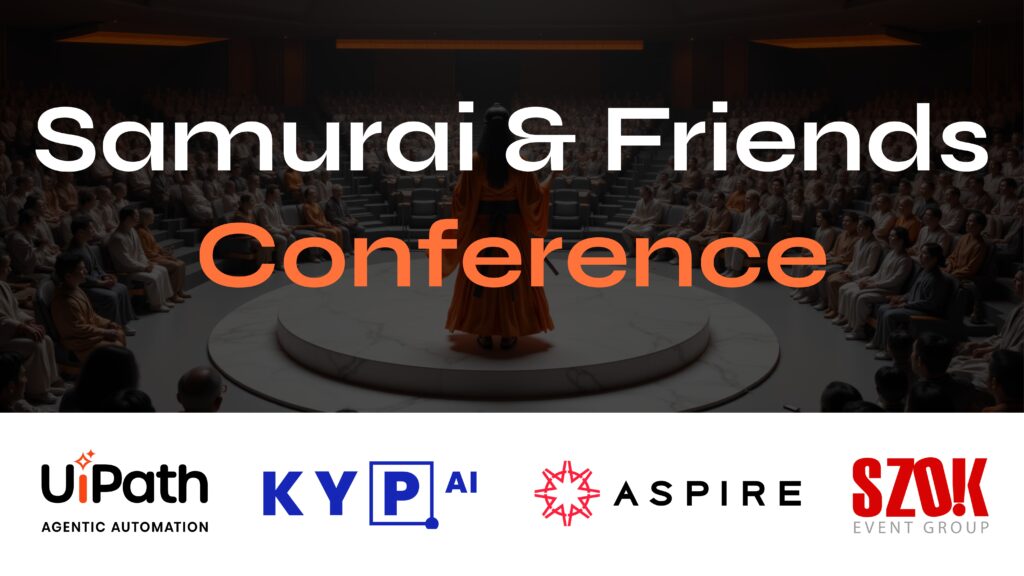
Day one highlights
(AK): So you were hosting day one keeping everything under control and on time. We started with my keynote talking about gaming industry. Any thoughts on that?
(DJ): Yeah I was really surprised and curious to see what you wanted to take from gaming industry into AI automation space. So I’m sure we’re going to make a podcast episode on that. So probably no point in digging deeper into that.
Presentation 1: Agentic Automation (Krzysztof Karaszewski from AgenciAI.biz)
(AK): Then we had Krzysztof Karaszewski from AgenciAI.biz. His topic was The new frontier: what is possible with agentic automation and we’ve known Krzysztof for a long time. What did you think?
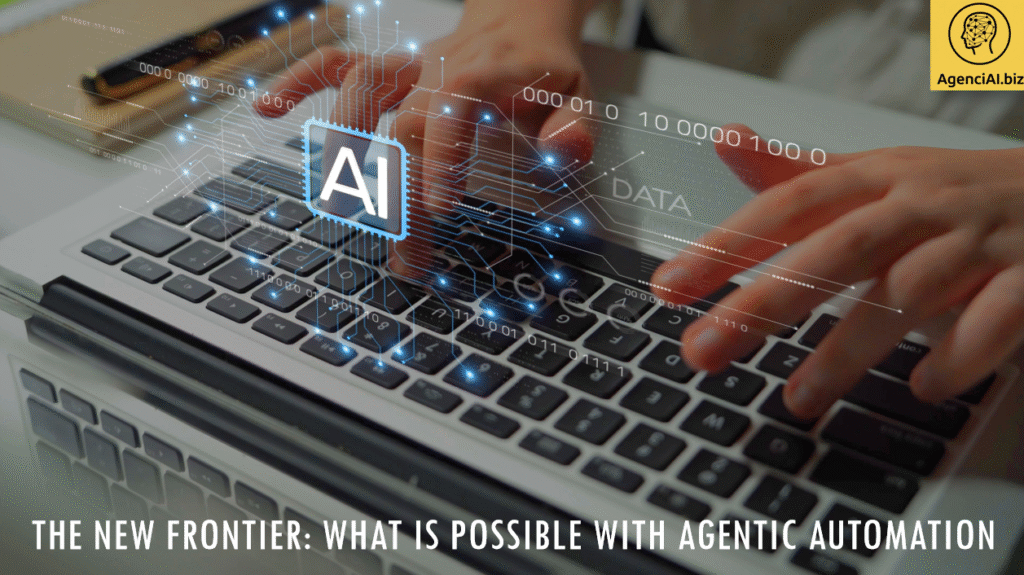
(DJ): Well it was I would say very different from other presentations which were focused on projects. So Krzysztof was showing what’s currently possible with AI and also how fast the models develop. I have two learnings from his presentation:
- LLM doesn’t matter that much right now right? Because the next month you will have some new LLM that will maybe solve the problems that you had in the past. So it’s not a matter if ChatGPT or Claude or Gemini or whichever of those you are using right. It’s I think more important just to have access to those foundational models in your organization.
- The second learning is about prompting right? To ask AI how AI could help us to ask another AI question properly.
(AK): This is something that a lot of people were very curious about because if you’re doing this you kind of already know and it feels kind of obvious but if you didn’t do it before it is kind of an aha moment that you can ask an LLM to write a prompt for an LLM and it’s doing it really really well. You still need to know what you want to get from it.
(DJ): I mean it also depends what you want from LLM right? If you are asking LLM what’s the biggest mountain in the world probably you don’t need a special prompt engineering techniques for that. But if you want LLM to do like some more complex real stuff right then you should focus more on the quality of your question. I think he call it meta prompting.
(AK): Meta prompting. Yeah that’s right. Another thing that I was quite curious about his experiments on using LLMs for process analysis. This is something that we have been discussing in the company quite a lot. It would help us a lot. It’s kind of a hit and miss right now. Some things work some others not as well as we would like them to.
(DJ): Definitely what I see currently is that our analysts are very actively using AI to do notes from the meetings right, summaries, next actions. So it still helps. But if AI could also draw the whole process map without much mistakes or at least have 80% of work done that would be perfect right? But I think the challenge is that those solution works well if you have a happy path but then if you are getting a lot of exceptions and you get back to like previous part of the process then add something more it’s much more complicated for AI to catch up with you.
(AK): Yeah I mean it’s hard for people so it’s even harder for AI. And most processes that we encounter are no longer just like simple and happy path kind of processes. And also Krzysztof has a lot of interesting posts on LinkedIn. So we encourage everyone to have a look at what he’s writing. He’s always trying to push the boundaries of what AI can do.
(DJ): There’s one more thing I actually remember from Krzysztof presentation. He was comparing UI agents right? So agents that instead of classical RPA robots you have selectors. You are telling the robot what to do step by step in application. And now with LLMs the concept is that you could prompt LLM “hey book me a flight to Dubai next week” or “hey I want a new skateboard, choose the best skateboard for my medium level skills and buy it for me”. And there are some examples on the market where LLM can order pizza for you for example. But when we are talking about real business processes and you will ask LLM “hey I want to hire Andrzej at my company right so contact Andrzej and hire him” LLM will not might have a challenge to figure out what it actually needs to do in order to hire you. Krzysztof was also showing comparison how I think Claude and their agentic UI operate on different application and he actually showed this was very interesting for me that LLM is learning application based on positions right? So it’s identify a buttons and then it knows I need to go 200 pixels down 100 pixels left and click another button right? But what if the resolution will change, what if the interface will change? So he was also comparing it to I think UiPath UI vision or UI agent something like this where the agent still receives the basic prompt what it needs to do but it’s actually working on selectors right? Not on the position of buttons which is interesting and from what I remember much faster approach.
(AK): Yeah but it’s going to be a really really long time until we let agents actually click things in our systems of on their own right? That’s something that this technology still has a way to go and to be sure that if you process tens of thousands of cases to just let agent decide every time it wouldn’t be efficient right? But it also would be quite risky at this point in time.
(DJ): And I guess for small businesses or for for private people that can take the risk it wouldn’t be a problem right? But for big corporations where you want the AI to stick to your process this might be a challenge. And this theme actually has been repeating at on on different speeches this thing about how do we make sure that AI and specifically Gen AI will not do stupid things.
Presentation 2: Email automation with AI (Kingfisher)
(AK): Then we had Dariusz Procyk and Miroslaw Rodzen from Kingfisher. So for those of you who don’t know the Kingfisher logo in Poland they have Castorama stores. In UK VNQI. It is a really big international company and having so many stores is a challenge on its own. And the title of their speech was Dear email we need to talk email automation with AI. And it is a project that we are actually doing together with them so we do have insight into what’s going on there. They get about 30,000 emails a month into their common finance mailboxes. And somebody has to process those emails right?

(DJ): And it’s not about only one mailbox right? Because it’s 40 something mailboxes if I remember correctly. So there are different teams different languages. So you cannot really put a simple form and ask everyone “oh now you need to fill the form and will manage it as a service request for example”.
(AK): And the story was about how we together built a framework based on a lot of different components but the component the AI component was communications mining. And the communications mining job was to take the email and structure the data extract the data that is needed for the robots to perform those processes. And there were quite a few interesting examples where those emails are sometimes even really hard for humans to handle. They don’t always contain all the information that is needed. Sometimes they are written in really strange ways. Sometimes they are a throwback to an email in the email thread that is like five emails back from what what they’re requesting. I actually remember two examples:
- One example was an email saying “Hey please do for me the same task as you did last week”. And you really need to know this person and find his or her former request to figure out what they want.
- Another example was with a picture right? So someone just sent a picture with information about usage of electricity in a shop. Just a photo and that was the whole body of the email right? And the task was to book in financial system how much electricity was used in a certain month.
(AK): So these are really good examples of how theory meets practice and we see that those technologies have come a long way and communications mining is a great tool and we had great success using it. But then certain kinds of projects the technology just isn’t enough right now. And that was basically the story is that now we are looking into using LLMs to process those emails because of their complexity the communications mining tool is not enough anymore. But of course using LLMs comes with its own challenges. You do not get a confidence score which is essential in this kind of processes.
(DJ): For those of you who doesn’t know communication mining because some of our listeners might hear this term first time. This is an approach where you’re teaching a machine learning model on quite big amount of emails what to do with them. How to categorize those emails into different categories. how to take different information from them. And it’s totally different approach with LLMs where you simply prompt that figure out what this email is about and hope for the best.
(AK): Yeah really interesting technology. I’m sure we’re going to have an episode about it. No perfect solutions for now when it comes to emails or tickets processing. We’ll see where the technology takes us. But I think this speech was very valuable from the perspective of what you mentioned before. It’s great to talk about things that worked but it’s even more important possibly even more important to talk about things that didn’t work so that others don’t have to make the same mistakes that we did.
Presentation 3: Digital interaction analysis (SPS Hungary)
(AK): Then we had Gábor Körmendi from SPS Hungary. And he has been talking the topic of the presentation was Digital interaction analysis: The SPS Hungary case. They have been talking about their how they use KYP.ai in their organization right? Dominik, you work with KYP.ai quite a lot.
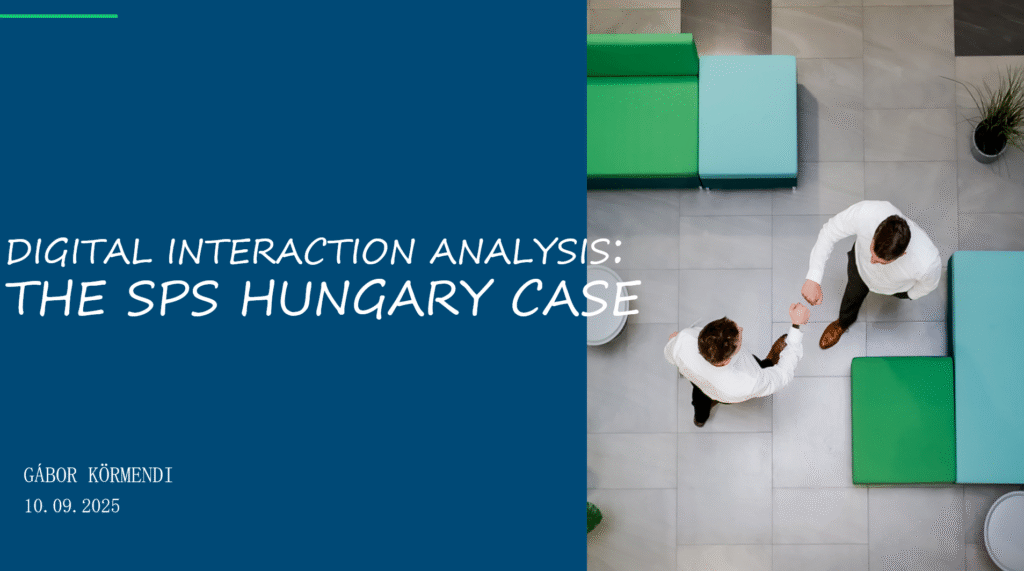
(DJ): SPS for those of you who doesn’t know the organization they are a BPO. So basically they outsource services. It used to be Swiss post services in the past part of the XC. Now they are a separate organization and of course they have a lot of repetitive tasks. They do processes for many customers mostly from Germany. And they need to book time right? So let’s say you Andrzej, you are spending 2 hours on a certain process for a BMW let’s say. And then they need to send an invoice right for your two hours of work to this company. So in the past people were basically manually choosing that now I’m working for company A and doing this process now I’m working for company B and doing this process. And with KYP.ai actually we found out that people spends around 4% of their time only selecting which processes they are doing. They actually had a cost of many thousand hours a year just just for this activity. So with KYP.ai they were able to reduce it because KYP.ai works in the background and it’s figuring out on its own what the people are doing and can make the measurements up to the seconds.
(AK): So you not only it doesn’t take people’s time but you also get results that are way closer to the truth than manual measurement.
(DJ): Additionally what they had was information about activities of their people. So they were able to see how much their people work, if some of them are underutilized or overutilized, how to better balance the work inside a team. However I was a little surprised that they are not using any process discovery features from KYP.ai. So features that can tell you what can be automated or improved in your processes that analyze and produce process maps out of the activities your people are doing. But from what I understand this is the next step in their journey that they want to take.
(AK): And it’s something that doesn’t cease to amaze me about KYP.ai is that when I first saw the tool I come from continuous improvement so my first thought was oh my god if I were to do lean management projects I would have such amazing data. But then we find that different companies use it for completely different purposes right and it still makes sense. So in the end it is a tool that different companies implement for completely different reasons.
(DJ): In SPS case it was operational steering. So they wanted to manage better their operations. But we have companies that use KYP.ai only for identifying cases for automation or improvement right, or that want to learn what type of processes they have.
Presentation 4: Start with lean and never stop (Euroclear)
(AK): The next one was Michał Baraniak from Euroclear. His topic was Start with… Lean. And never stop. Story of continuous transformation of Euroclear Bank. This one was like right up my alley right? I come from Lean Management and I made my career doing Continuous Improvement. And actually Michal was a part of my team at Lufthansa. Euroclear is a bank for the banks. So they handle transactions between banks and a lot of really important stuff that basically you know it can make the world stop if something doesn’t work at at Euroclear right? Any thoughts on what they are doing in Euroclear?
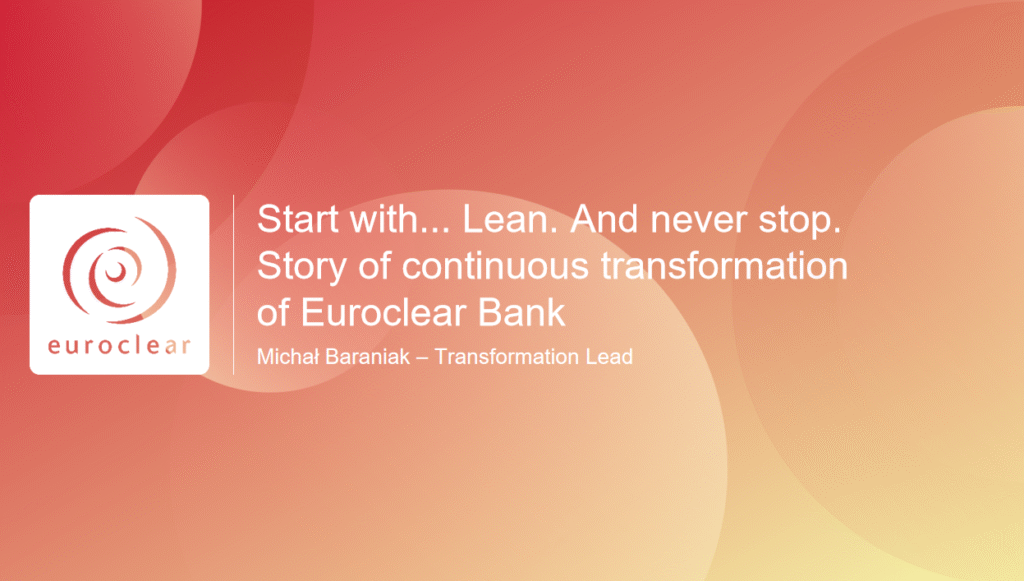
(DJ): I mean it was very different from a typical lean transformation. What we are very often seeing is lean transformation black belts coming to a company introducing Kaizen, so those small improvements everyone can submit, implementing maybe boards for the teams or standup meetings. I would say more basic things that create this basic of lean culture. And Euroclear is quite different because they already did this for many years and they figure out that they cannot truly focused on a team level when doing lean transformation. So they started doing end to end projects where they were analyzing what different teams are doing but within end to end process. And it was I think very surprising for me to see the example that Michal showed that they had a process I think it had 95 steps or something like this. Also there were a couple of teams and the teams were moving the tasks between them 50 times during the process. When they analyzed it and they showed the results to the teams and tried to redesign how it should actually looks like I think they reduced the number of steps to 40. I think the places where they move processes something like 15 maybe. So they simplified significantly the process. They also reduced the lead time several times. So from several days I think to one day. And if you think about automation and if you had RPA team or even AI team now coming to this first version of the process right and asking how we can automate it with LLMs with AI, maybe they could improve few places and have some quick wins but actually this would be a huge waste of time.
(AK): That is true and this is something that it’s like the holy grail of Continuous Improvement is improving end to end processes. And everybody talks about it and everybody wants to do it but there’s so few companies that are actually doing it. And here they do it but it is as you said it is a logical set of steps. So they started with basic. They have the dashboards. They have the meetings that all of those things they did. But then they didn’t stop there. They go with more and more complex things. And it really works right? It’s years and years of work. And also what is really important is that you cannot stop. You cannot change the course after a few years because this is what often happens, you know a new managing director comes and they set up this continuous improvement program, they do it for three or four years, great results, and then the managing director goes somewhere else. A new one comes and says “No no no We’re going to be doing something else”.
(DJ): That’s true. There’s one more thing that I think was quite special about them is that they put on the first place the customer. This whole transformation was customer centric and they actually invited customers to take part in those projects to give them feedback, to listen to so-called voice of the customer.
(AK): That is absolutely spot on. Everybody says they’re doing it. Everybody knows it should be done but almost no one is doing it.
Presentation 5: RABuy automation initiative (Rockwell Automation)
(AK): The next speech was by Sawa Konfisz and Jakub Markowski from Rockwell Automation. Rockwell Automation is a company doing automations as the name suggests. But they do those automations that everybody kind of thinks about when you are saying robots actually actual physical industrial automation. But they have been talking the title of the speech was RABuy: Automation initiative removing SAP from purchasing workflow. And I really like the idea because they thought of something that I myself probably wouldn’t have thought of. So basically when they have to put purchase requests in their system and they purchase a lot, they take the quote they received from the vendor and they upload it to a system and the AI kind of reads the quote and it makes it into the purchase order. Which once you have seen it it’s the most logical thing to do. It looks obvious.
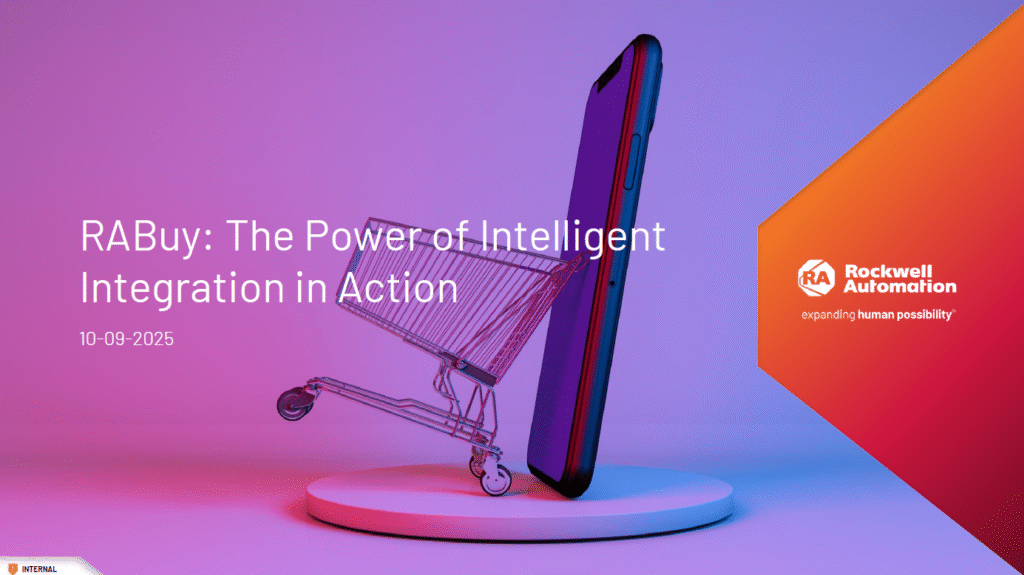
(DJ): And if you think about this this doesn’t sound spectacular. But when they were talking about numbers I actually took my phone, open calculator and quickly calculated that actually they increased productivity for the whole company something like 50 FTE if I remember correctly. I’m not sure sure if they were able to translate them to P&L right but even if you have soft savings for 50 FTE across your whole organization of up to several thousand people it means your employees can focus on more important things than putting orders into the system.
(AK): It’s not something that people like to do. Manual data entry is not people’s favorite thing to do. And they created this neat tool with with easy to use interface where it does things for you. But of course having in mind that LLMs still hallucinate and make mistakes, the final step is basically for a human to have a look at what it understood from the quote and do some changes if necessary and then just let it create.
(DJ): There’s also another perspective how you can see it because they actually used low code application development. So they created their own low code application which looked much better than their old SAP legacy system. They were also able to resign from SAP licenses which might be not very nice information for SAP but for sure Rockwell had some savings out of this.
Day two deep dives
(AK): That was a wrap for day one. We are not going to go into the details when it comes to the after party. It was phenomenal though. And then day two because day one those speeches are 30 minutes long, there is a little bit time for questions but we focus more on getting the ideas out on inspiring people showing them use cases. And then day two we use for deep dives. So we have less speeches but they are longer an hour long and we go more into detail about the implementation and about often technical details of what’s going on in there. Dagmara Sysula, our Delivery Manager was hosting this one.
Presentation 1: P2P service desk AI agent (McCormick)
(AK): The first one we had on day two was by Radoslaw Ociepa from McCormick. He was talking about P2P service desk AI agent. This is something that is kind of close to our heart because this is something that we also have worked on the last few months. How did you find it?
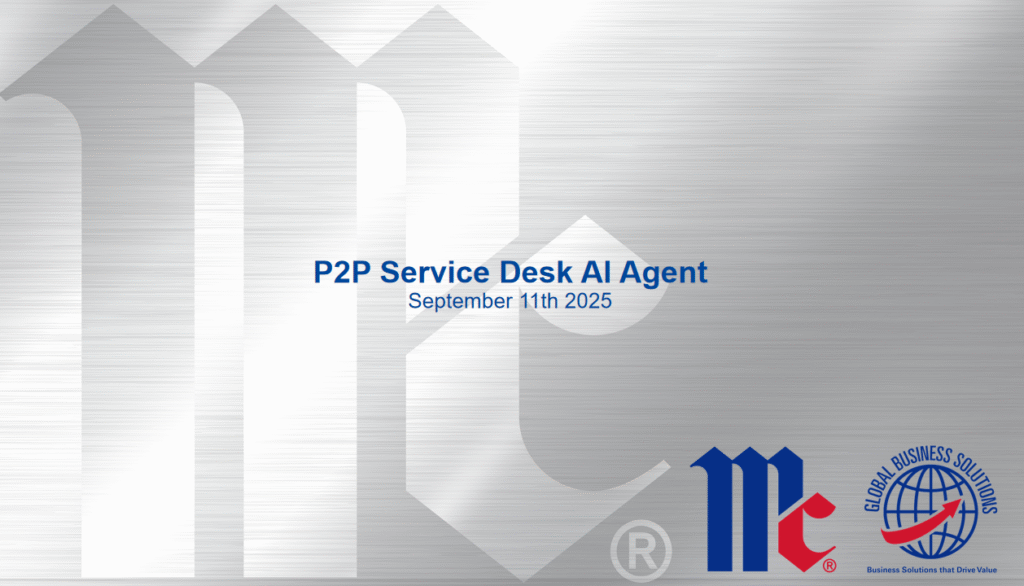
(DJ): I think that those service desk agent no matter if we are talking about finance, HR, procurement or IT help desk, this is a place where a heavy number of automations with AI will actually take place. This is also my suspicion when we are talking about for example Salesforce layoffs right? They announced out of 9,000 people in their customer operations I think they reduced the number by 4,000. And my suspicion is this is mostly level one service desk agents.
(AK): And I think when we hear about those huge layoffs that the companies are doing most of them I think are bullshit from the perspective of they say it’s because of AI but AI adoption isn’t that high. It’s just an excuse to do something you would have done anyway. But in this example that you talk about I think that may be it. It’s something that Gen AI is really really effective in in those processes. L1 absolutely. Learning for you if you are looking for a good area to start with AI, service desk type of work might be a good place. They put it together using UiPath agents which is quite a new thing. I mean it’s few months old right when it comes to general access. But they showed that thanks to this technology they can implement things and they can implement them pretty fast. Because if they were to build it from scratch it would require a lot and a lot of effort and it would require a lot of skill that I don’t know if they do have within the organization or possibly they would have to probably some machine learning DevOps engineers and people like that.
(DJ): So this allows them as they’re already have the UiPath platform and using robots. So this makes it way way easier for them to to implement. And I’m really looking forward. They have said that they started with the P2P service desk because on a P2P service desk you get a lot of repetitive questions like “hey what’s the status of my invoice”.
(AK): And it makes sense to start there but they already have plans to use the same technology to go and and do the same thing with with other service desks. And we were able thanks to having an hour we were able to go quite deep when it comes to how they did it. We saw exactly how they build the agents.
(DJ): I think it was quite common setup right? Because they had I think three or four applications where you need to check information. There was SAP, Ariba and some other two. And depending on the use case you either need to go to one of it. So it’s not like agent working only within one application but you really need to orchestrate what the agents are doing. Plus the agents were not doing the whole work right? There were also integrations in place. There were also RPA robots. So classic stuff. And the agents were used to understand what the question is about. But then once you know it you don’t really need agent to do the work. Yes you can have like a classic automation for that.
(AK): Absolutely. And I think they used another agent to write a nice reply from the data that the robot gives to an agent. But it makes sense and it clearly shows that you don’t want to use AI for everything. There’s pieces where AI makes sense and there’s pieces where other technologies do. You know what one thing surprised me in this presentation?
(DJ): They mentioned that there is no human in the loop. And that their business director he asked them not to verify the emails that are being sent. So for me it was really surprising that they actually did it and we typically recommend people to have some kind of final verification by the human or maybe early verification if the agent is going proper direction.
(AK): And people were asking about this and it was discussed. Basically those processes that currently are performed by the agent are very low risk right? I do agree I would probably advise at at least at the beginning the first few weeks to put human in the loop but we like brave people who do brave things.
Presentation 2: UiPath act two agentic automation (UiPath)
(AK): Then we had Piotr Zajac from UiPath. UiPath Act 2: Agentic Automation. That was a lot of information.

(DJ): That was I think the most packed presentation. So Piotr is speaking very quickly and he was very quickly showing how UiPath is transforming their organization and products from like traditional RPA to AI first automation. I guess it was first of all interesting for UiPath customers maybe not so much for those using Blue Prism or Automation Anywhere. But when we spoke if we could really invite other vendors to the conference and ask them to to speak about the AI capabilities we’re like we’re not sure if they would have a proper story to tell. The answer may be what AI capabilities?
(AK): UiPath is working on the AI side of the business heavily kind of to a point where they do see it as act two as this making their platform into something completely different. It doesn’t mean they’re going to stop delivering robots and so on because it has a part in in the whole landscape. But they rightfully say that it’s no longer enough and so all those AI capabilities they they have to be there because this is what the customers are are expecting.
(DJ): And long story short I have the feeling that UiPath is trying to put AI into every type of their product right? So they put it in robots like self-healing selectors. They put it in test automation like AI use cases for tests. They put it to process mining. So basically document extraction. So everywhere you could think AI could be potentially used but they already have the whole framework right? So they are not building it from a scratch.
(AK): And also it’s important that those AI features are kind of optional in a way that if you don’t like the idea of self-healing selectors which I personally have doubts about and I’m sure my developers have doubts too then you just don’t use it right? But you have an option to use it when when it fits when it makes sense.
Presentation 3: KYP.ai and the unexpected findings (Office Samurai)
(AK): Then we had Zuzanna Pamula and Michal Kozubski both from Office Samurai talking about KYP.ai and the unexpected findings. This was something that I mean I work with them on daily basis but I I was still really looking forward to this one as they tried to gather as many surprising things that they would find or our customers would find with KYP.ai during the projects. Like we discussed earlier KYP.ai can be used for a lot of different things.
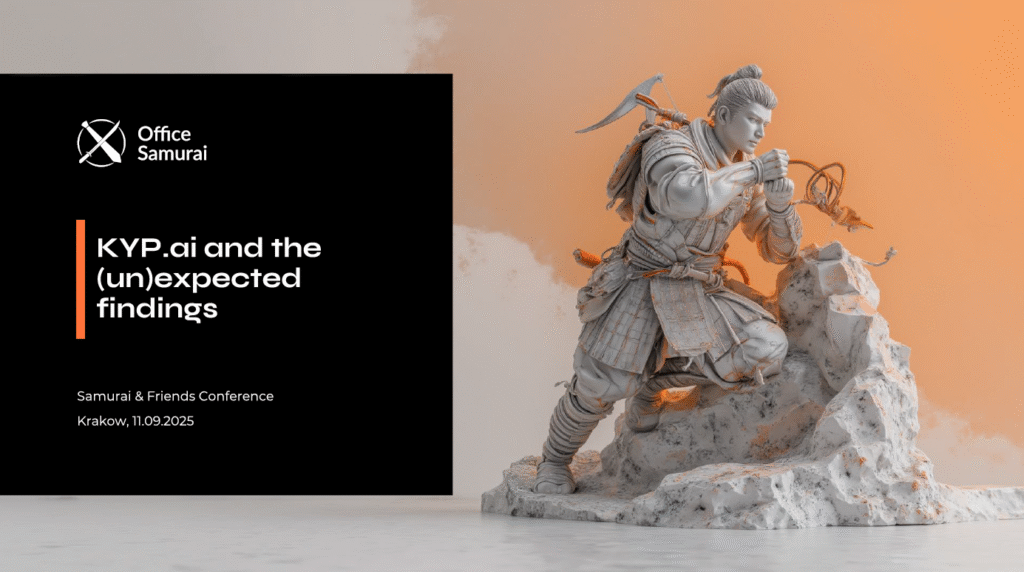
(DJ): But for for me the biggest learning from it was that maybe we should think about creating more custom dashboards in KYP.ai where you could find out how much your meeting costs in your organization. Because also showing for really nice examples where a work of manager is being analyzed right? And you know manager typically in organizations right now they would use Outlook maybe Teams maybe a little of Excel. And instead of sometimes doing the work they they are mostly meeting with people and talking with people. Sometimes justified sometimes probably could be reduced. But you don’t really know what’s the scale of it and with KYP.ai you can actually calculate how much your daily meetings cost you.
(AK): And it is something that for managers it is the bulk of their work. But even operational employees they spend a lot of times on meetings right? And you need a certain amount of meetings to for things to work but a lot of the organizations have too many meetings and those meetings just get in the way of employees doing their job.
(DJ): When I’m thinking about this I never heard in any organization that we have not enough meetings. What I’m usually hearing we have enough which is like a perfect situation or we have too much which is like 80% of cases.
(AK): I am trying to convince Zuzanna or Michal to actually make a podcast episode a solo podcast episode about this. So stay tuned. We’re going to be back with with more examples.
Presentation 4: AI automation playbook (Dominik Jaskulski)
(AK): And then the cherry on top, Dominik Jaskulski with a speech AI automation playbook. It was something for me it was something that I was thinking for the for the whole of your speech, I was thinking we should have created something like this sooner. So you put together thoughts and frameworks and ideas about how AI should be introduced in organizations.
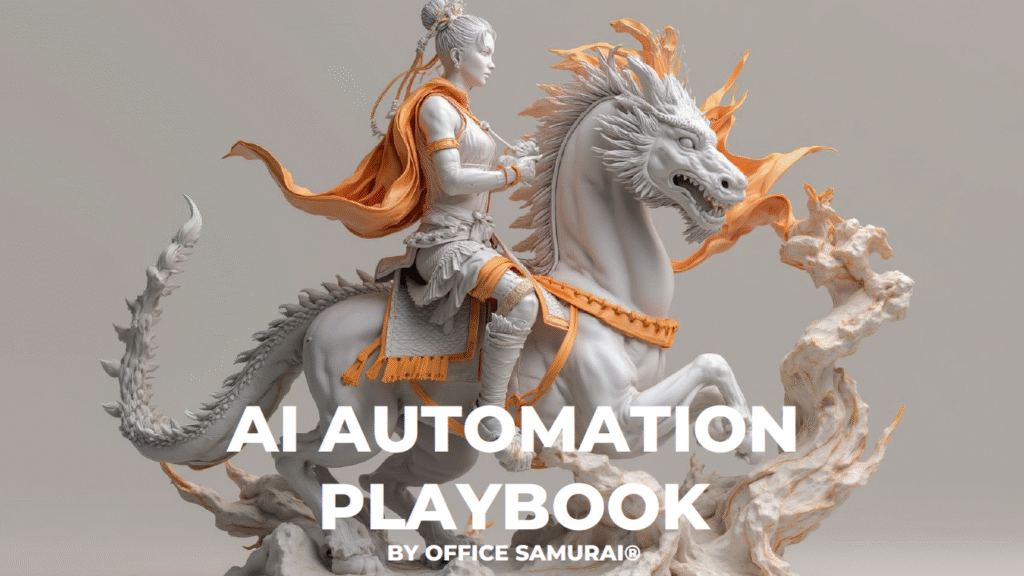
(DJ): Honestly speaking I made this presentation by coincidence because I was planning to do presentation about AI use cases. So where you should start looking for use cases which of them make sense which not to give people some summary right that they are leaving the conference with actual ideas where to start. But then when I started to making all those slides together I was missing something in the story. So I came up with this idea that you have basically few main phases of what you should do to properly implement AI in your organization. And it was also created based on the feedback or lessons learned from two reports. So one report was from McKinsey another one from MIT. Both of those reports they were talking about a type of a gap where basically a lot of organizations have this horizontal implementations. By horizontal they mean that you are for example giving access to ChatGPT or access to Microsoft Copilot to all employees right and some of them are using it some not. And it’s really hard to get and measure benefits out of it. KYP.ai can help you with measuring benefits in those scenarios but it’s still hard to translate those benefits into P&L. I think McKinsey they figure out that only 1% of organizations think the AI strategy is major. And in addition to those horizontal projects you also have vertical projects. Like this P2P service desk agent from McCormick. This is an example of vertical project or maybe Rockwell automation right? So they did a project in a certain area with end to end process that resolves some type of problem the organization is having. And actually only 5% of those projects succeed. A lot of them most of them actually stuck in POC or pilot phase. And the conclusion was that these are type of projects that give you real benefits that translate to P&L. However it’s not very easy to start with those projects. So my proposition was to introduce AI in phases. To start with in horizontal way with chatbots, Copilots, then maybe go to AI assistants. So AI that is plugged in into your knowledge, your databases, can answer questions about your the information that you already have in your systems can summarize it etc. Then next stage would be simple AI agents. So AI agents that can actually do something for you but in a single system. I think both the cases with McCormick and Rockwell was a good example of those single agent because agent just had one task to do you didn’t need to synchronize a very complex agentic system. And this is actually the last level right where you need to orchestrate the agents. Sometimes maybe the agent will need to orchestrate other agents. So before you get to this level you actually should do some homework and have some basic stuff in my opinion.
(AK): This last level is not many companies out there and it’s clear non companies are there on a big scale. It’s true whatever it is you’re doing you if you want to do it responsibly and not only in PowerPoint then you need to take a certain amount of steps before before you get there. And this MIT report it’s brutal like I mean I’ve I’ve read it and it’s I had a feeling it’s kind of like this that only 5% of those projects actually succeed and bring benefits. I thought it would be higher than 5%. The fact that 40% of organizations have introduced Copilots or AI chatbots for their employees where in 90% of companies employees are already using them. It means your data is being sent to someone’s cloud without your consent without any supervision. I think it’s a great finding because you know if you are in IT security then you need to realize that if you do not give a safe way for your employees to use AI they’re just going to use it in an unsafe way right and you’re not going to be able to stop them.
(DJ): And another thing is training right? We have seen a lot of organizations have for example buying generic trainings or asking their employees you know just to do some YouTube videos or or have a training what is LLM but then they cannot really translate it to their work. I was showing an example with one company I cannot mention where where the team was analyzing like very heavy transactional SQL queries like thousands of lines. I put those whole queries into I think it was Copilot right? Just created a simple prompt and in seven minutes they had a result where they previously had a team of three people doing this task the whole day. Based on the MIT research if you do if you start implementing AI in your company by yourself you have only 50% of the chances compared to implementing it with an external experienced partner.
(AK): The speech that you gave I will also be chasing you about making it into an episode of the podcast. To sum up those two days have been exhausting for us for sure but it was extremely good to hear all the stories that the companies had to tell and to meet all those people that are interested in those topics.
(DJ): And you know actually I feel very inspired and energized. And this is usually the main reason why I was taking part into conferences right? One thing was to learn something new. But this inspirational part and this excitement that hey we actually have the same problem and they already showed us how to solve it. So let’s do it at our company as well.
Conclusion
(AK): And that’s a wrap on our samurai and friends debrief. The stage is empty the banners are down and the last of the complimentary cookies have been fought over and consumed. Dōmo arigatō for tuning into our victory lab. A massive heartfelt thank you to the real heroes of the event the speakers and the companies who shared their stories. This episode and the conference itself wouldn’t be possible without our producer Anna Cubal the master strategist behind the scenes. We record in the legendary Wodzu Beats Studio where we are already whiteboarding ideas for the next event. If this recap made you want in on the action next time make sure you’re following us on social media for announcements. Until next time keep your processes automated and your conferences bullshit free. Mata ne.




